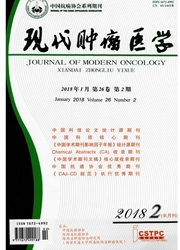

 中文摘要:
中文摘要:
目的:探讨颅内动脉瘤夹闭术中使用神经内镜辅助的效果.方法:回顾性分析我院56例颅内动脉瘤夹闭术中使用神经内镜辅助的临床效果,包括前交通动脉瘤22例、后交通动脉瘤12例、眼动脉动脉瘤5例、大脑中动脉动脉瘤13例及基底动脉尖动脉瘤4例,通过术中监测设备及瘤体穿刺,术后2周复查CTA,3个月后复查DSA,观察动脉瘤夹闭情况.结果:54例术中证实完全夹闭,完全夹闭率96.4%;2例术中包裹加固病例,通过两次复查残余瘤体未见明显变化.结论:动脉瘤夹闭术中使用神经内镜辅助,从多角度显示动脉瘤的形态及夹闭情况,有效避免误夹或夹闭不全,可提高手术疗效及安全性.
 英文摘要:
英文摘要:
Objective:To investigate secondary effects for neuroendoscope in intracranial aneurysm surgery.Methods:A retrospective analysis was performed on 56 cases in our hospital including 22 cases of anterior communicating artery aneurysms,12 cases of posterior communicating artery aneurysms,5 cases of ophthalmic artery aneurysms,13 cases of middle cerebral artery aneurysm,4 cases of basilar artery aneurysm.The methods were intraoperative monitoring,the tumor puncture,two-week-postoperative DSA and three-month-postoperative DSA.Results:Complete clip was confirmed in 54 cases with ratio of 96.4%.2 cases used wrapped reinforcement in operation with no significant changes in the residual aneurysm by two reviews.Conelusion:Neuroendoscope in intracranial aneurysm surgery can display aneurysm morphology and clip conditions from multiple perspectives.It also can avoid false clip or incomplete clip effectively to improve the operation effect and safety.
 同期刊论文项目
同期刊论文项目
 同项目期刊论文
同项目期刊论文
 期刊信息
期刊信息
